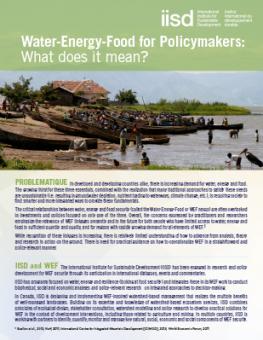
Water-Energy-Food for Policymakers: What does it mean?
In developed and developing countries alike, there is increasing demand for water, energy and food (which combine to form what is called the WEF nexus).
The growing demand for these three essentials, combined with the realization that many traditional approaches to satisfying this demand are unsustainable (i.e., they result in groundwater depletion, nutrient loading to waterways, climate change, etc.), is requiring society to find smarter and more integrated ways to provide these fundamentals.
In Canada, IISD is designing and implementing WEF-inspired watershed-based management that realizes the multiple benefits of well-managed landscapes. Building on its expertise and knowledge of watershed-based ecosystem services, IISD combines principles of ecological design, stakeholder consultation, watershed modelling and policy research to develop practical solutions for WEF in the context of development interventions, including those related to agriculture and mining. In multiple countries, IISD is working with partners to identify, quantify, monitor and manage key natural, social, economic and social components of WEF security.
Two examples given in this brochure of IISD’s engagement with WEF security include its work developing cattail-based value chains in the Lake Winnipeg watershed (Canada) and working with stakeholders in Suriname to help them understand and improve WEF in the context of mining.
You might also be interested in
National State of the Environment Report: Uzbekistan
The National State of the Environment Report (NSoER) is a comprehensive document that provides a snapshot of current environmental trends in Uzbekistan's socio-economic development for citizens, experts, and policy-makers in the country of Uzbekistan.
IISD Annual Report 2022–2023
At IISD, we’ve been working for more than three decades to create a world where people and the planet thrive. As the climate crisis unfolds on our doorsteps and irreversible tipping points loom, our team has been focused more than ever on impact.
Freshwater connectivity can transport environmental DNA through the landscape
A new study conducted at IISD-ELA found that the movement of water between freshwater bodies can transport eDNA which complicates the question of how accurately it can be used to monitor species.
Microplastics now pervasive in Great Lakes, with 90% of water samples surpassing safe levels for aquatic wildlife: new studies
Data spanning the last ten years reveal that the Great Lakes basin is widely contaminated with microplastics, with potentially dangerous consequences for the wildlife that live within.